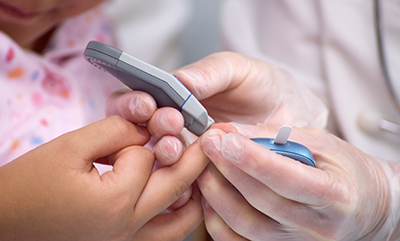Diabetes and Diabetic Kidney Disease Rising among Youth.
 The prevalence of pediatric diabetes (types 1 and 2) increased among commercially insured young people in the US from 2002 to 2013, with the highest prevalence among youths ages 12 to 17, a new study led by School of Public Health researchers shows.
The prevalence of pediatric diabetes (types 1 and 2) increased among commercially insured young people in the US from 2002 to 2013, with the highest prevalence among youths ages 12 to 17, a new study led by School of Public Health researchers shows.
The study, published in the journal Diabetes Care, found that prevalence of pediatric diabetes increased over the study period, while the prevalence of diabetes nephropathy, or kidney disease, also increased. Although type 1 diabetes—an autoimmune disease—accounts for a majority of childhood and adolescent diabetes, type 2 diabetes has become more common with the increasing rate of childhood obesity, the authors noted.
The research team tracked diabetes prevalence in a large commercial claims database, identifying more than 96,000 pediatric patients with diabetes and 3,161 with diabetic nephropathy from 2002 to 2013.
The annual prevalence of diabetes in the whole pediatric population increased from 1.86 youths per 1,000, to 2.82 per 1,000 (an average 3.7 percent increase per year). Type 1 diabetes rose from 1.48 per 1,000 children to 2.32 per 1,000, while type 2 rose from 0.38 per 1,000 to 0.67 per 1,000 from 2002 to 2006, then declined slightly from 0.56 to 0.49 per 1,000 thereafter.
During the same time period, the prevalence of pediatric patients with diabetic kidney disease rose from 1.16 percent of all pediatric diabetes cases to 3.44 percent.
Study co-author Susan Jick, director of the Boston Collaborative Drug Surveillance Program at SPH and a professor of epidemiology, said the slight decline in type 2 diabetes in the later years of the study was encouraging.
“Diabetes is associated with significant morbidity, so it is very good that the prevalence is going down. We hope that it continues to go down,” she said.
She said the study’s findings serve to “highlight the importance of monitoring kidney function in all patients with diabetes, even in children.”
While the prevalence of type 1 diabetes was higher in male than in female youth, the opposite was true for type 2 diabetes and diabetic kidney disease, which were more common in females.
Jick and co-authors said they could not speculate about the causes for the increase in type 1 diabetes. They also noted that the prevalence of diabetic nephropathy was “extremely low” in the pediatric population, confirming that the condition is uncommon among youths.
Co-authors on the study include Lin Li, an epidemiologist with the Boston Collaborative Drug Surveillance Program, and researchers with Bayer Pharma AG. The study was sponsored by Bayer Pharma AG.